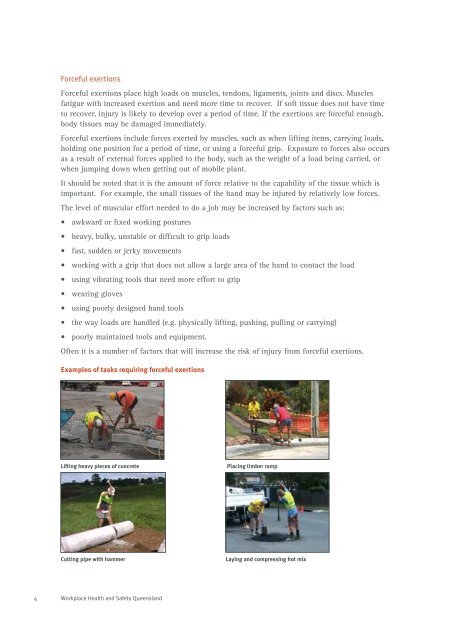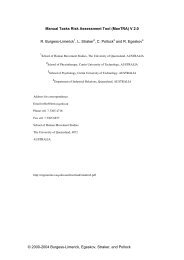d6 - Burgess-Limerick
d6 - Burgess-Limerick
d6 - Burgess-Limerick
- No tags were found...
Create successful ePaper yourself
Turn your PDF publications into a flip-book with our unique Google optimized e-Paper software.
Forceful exertions place high loads on muscles, tendons, ligaments, joints and discs. Muscles<br />
fatigue with increased exertion and need more time to recover. If soft tissue does not have time<br />
to recover, injury is likely to develop over a period of time. If the exertions are forceful enough,<br />
body tissues may be damaged immediately.<br />
Forceful exertions include forces exerted by muscles, such as when lifting items, carrying loads,<br />
holding one position for a period of time, or using a forceful grip. Exposure to forces also occurs<br />
as a result of external forces applied to the body, such as the weight of a load being carried, or<br />
when jumping down when getting out of mobile plant.<br />
It should be noted that it is the amount of force relative to the capability of the tissue which is<br />
important. For example, the small tissues of the hand may be injured by relatively low forces.<br />
The level of muscular effort needed to do a job may be increased by factors such as:<br />
• awkward or fixed working postures<br />
• heavy, bulky, unstable or difficult to grip loads<br />
• fast, sudden or jerky movements<br />
• working with a grip that does not allow a large area of the hand to contact the load<br />
• using vibrating tools that need more effort to grip<br />
• wearing gloves<br />
• using poorly designed hand tools<br />
• the way loads are handled (e.g. physically lifting, pushing, pulling or carrying)<br />
• poorly maintained tools and equipment.<br />
Often it is a number of factors that will increase the risk of injury from forceful exertions.




